By Willeke van Staalduinen, AFEdemy, Academy on Age-Friendly Environments in Europe B. V.
Interview with Jesper Schulze, ISIS Sozialforschung, Germany
Why did you initiate the Smart for Democracy and Diversity (SDD) project?
At ISIS Sozialforschung we have been dealing with the issues of discrimination and participation for many years. We try to develop concepts and ideas to combat discrimination. When dealing with discrimination, it is important to become aware of your own patterns of behaviour and thinking. And I think that works best when you manage to change your perspective. I think that people often see their own experiences as typical and cannot imagine how other people experience such situations. Or how one’s own attitude can negatively affect other people, even if it is not meant negatively. The idea of the SDD project was to develop an educational project that enables such a change of perspective with digital means. I believe that digital methods or playful elements make the topic much more accessible and tangible.
What did you like most thus far in the project? Why?
I am very happy with the positive response to the project. On the one hand, there is the great participation in the workshops and the willingness to talk openly with us about experiences, but also the interest in discussing the contents and always giving tips for improvements. I think the project is very lively and includes the experience of many different people. And I personally think that it is very exciting to have this exchange and to talk to people.
What is the most important thing you learned or take away from the project for you thus far? Why?
What I find very exciting is the work on the storyboard and the development of the scenes for the educational game. Here it is about transferring the experiences from the interviews into a fictional story that should nevertheless be realistic. This requires a very intensive examination of stereotypes, the choice of words and also the question of how certain contents are portrayed. How can you portray something aggressive and discriminatory and prepare it as learning material without simply reproducing it? I had many intensive discussions, also about content that I did not find problematic, but where others said from their own experience that we cannot do it that way. This is a process from which I learned a lot and which I found exciting.
What are the next steps you will work on in the project?
We are currently finalising the storyboard. That means we have written it, we have discussed it in the workshops and it was evaluated and we are currently revising it. This is a very important step in terms of content and when it is finished, we can continue with the development of the graphics. Personally, I will accompany this process and then focus on digital methods that we will integrate into the interactive learning platform.
